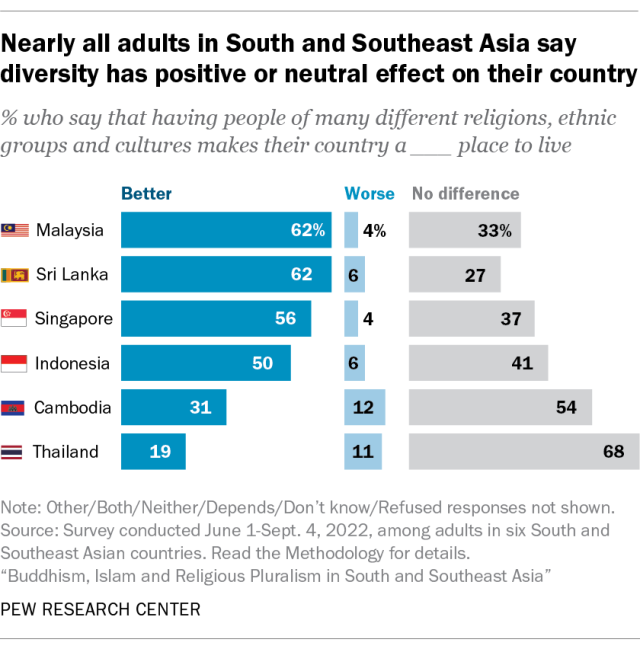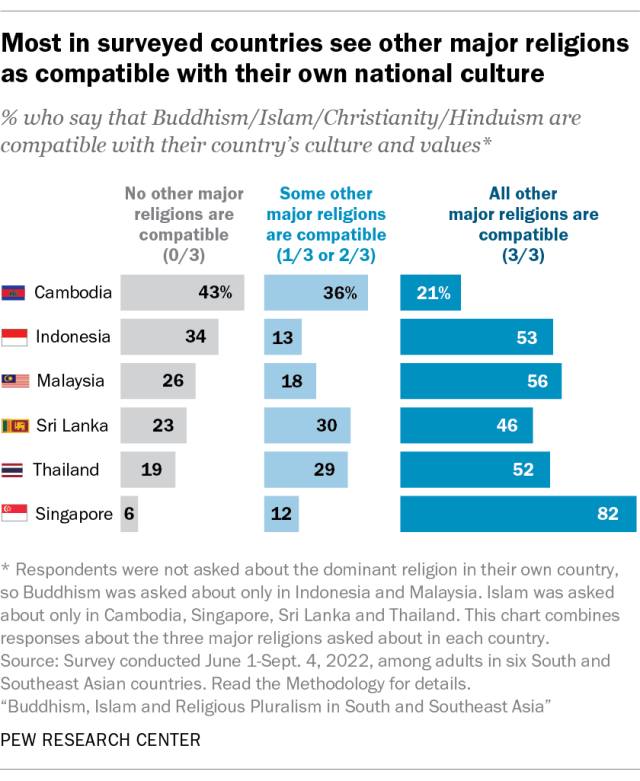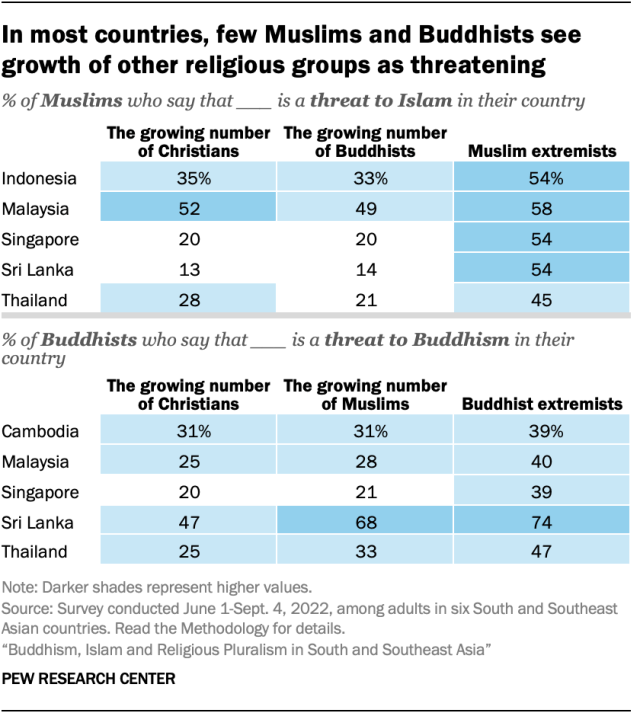The populations of Cambodia, Indonesia, Malaysia, Sri Lanka and Thailand each have large religious majorities, with at least seven-in-ten adults being Buddhist or Muslim. In some of these countries, there have been significant tensions with minority religious groups in recent years.
Yet a 2022 Pew Research Center survey finds that, on balance, adults in these five South and Southeast Asian countries are generally supportive of religious diversity. These findings are similar to those in Singapore, a country that lacks a religious majority. This analysis explores religious tolerance and views of minority groups in these six countries.
This analysis is drawn from the Pew Research Center report “Buddhism, Islam and Religious Pluralism in South and Southeast Asia.” For that report, we surveyed 13,122 adults across six countries in South and Southeast Asia using nationally representative methods.
The survey included three countries in which Buddhists make up a majority of the population (Cambodia, Sri Lanka and Thailand); two countries with Muslim majorities (Malaysia and Indonesia); and one country that is religiously diverse, with no single group forming a majority (Singapore).
Interviews were conducted face-to-face in Cambodia, Indonesia, Sri Lanka and Thailand. They were conducted on mobile phones in Malaysia and Singapore. Local interviewers administered the survey in eight languages from June to September 2022.
Respondents were selected using a probability-based sample design. In Thailand, this included additional interviews in the country’s Southern region, which has larger shares who are Muslim. Data was weighted to account for different probabilities of selection among respondents and to align with demographic benchmarks for each country’s adult population.
For more information, refer to the report’s methodology section or the full survey questionnaire.
Perceived impacts of religious diversity

In Malaysia, Sri Lanka, Singapore and Indonesia, at least half of adults say that having people of many different religions, ethnic groups and cultures makes their country a better place to live.
Meanwhile, majorities in Cambodia and Thailand state that diversity doesn’t make much difference either way.
Looked at more broadly, nearly all respondents in the six countries say diversity has either a positive or a neutral impact on their country. For example, 62% of Sri Lankan adults say diversity makes their country a better place to live, while 27% say it doesn’t make a difference.
And in religiously diverse Singapore, where no group constitutes a majority, 56% of respondents say diversity makes their country better, 37% say it makes no difference and only 4% say diversity worsens their country.
Compatibility of other religions with national culture and values

The survey asked respondents whether the major religions in South and Southeast Asia – Buddhism, Islam, Christianity and Hinduism – are compatible with their country’s way of life. (The question focused on attitudes toward minority religions, so respondents were not asked about their country’s historically predominant religion.)
Singapore is the most accepting of various religions. About eight-in-ten Singaporeans (82%) say that Islam, Christianity and Hinduism are also compatible with their national culture.
And in several other countries, around half of respondents say that all three of the major religions asked about are compatible with their national culture. For example:
- In Buddhist-majority Thailand, 52% of adults say that Islam, Christianity and Hinduism are all compatible with Thai culture and values.
- In Muslim-majority Indonesia, 53% of respondents say the same about Buddhism, Christianity and Hinduism.
In contrast, Buddhist-majority Cambodia stands out because 43% of Cambodians do not say that any of the other three religions (Islam, Christianity or Hinduism) are compatible with Cambodian culture and values.
Another way to understand people’s religious tolerance is by asking whether they would be willing to live next door to members of other religions. Across the six countries, majorities of all major religious groups say they would be willing to have neighbors from other religions. Adults ages 18 to 34 are particularly open to this.
Adoption of religious practices from other faiths
Many people in South and Southeast Asia practice religion in a pluralistic way. Across the region, substantial shares of adults pray or offer respect to deities or religious figures commonly associated with another faith.
For example, a quarter of Singaporean Buddhists say they pray or offer their respects to Jesus Christ, while over a third of Malaysian Christians say they do so to Allah.
In general, Hindus are the most likely to pray or offer respects to deities not traditionally associated with their religion, while Muslims are the least likely.
Minority religious groups seen as less of a threat than extremists

Though Muslims and Buddhists are the majority religious groups across South and Southeast Asia, most of them generally do not see growing populations of other religious groups in their countries as threats to their religion. Among Thai Buddhists, for instance, only a quarter feel threatened by the growth of Christians and a third by the growth of Muslims.
(These questions were designed to gauge demographic anxieties, regardless of whether these minority populations are actually growing within the countries surveyed.)
However, in a few countries, a substantial number of Buddhists and Muslims do see growth of other religions as a potential threat. Around half of Muslims in Malaysia say growing numbers of Christians (52%) and Buddhists (49%) are threats. And 68% of Buddhists in Sri Lanka say the growing number of Muslims is a threat.
Across the region, most Muslims and Buddhists are more likely to see extremists from their own faith as a threat than growth in other religions. For instance, 54% of Singapore’s Muslims say Muslim extremists are a threat, but far fewer say the growing number of Christians or Buddhists is a threat (20% each).
Note: For more information, refer to the report’s methodology section or the full survey questionnaire.
